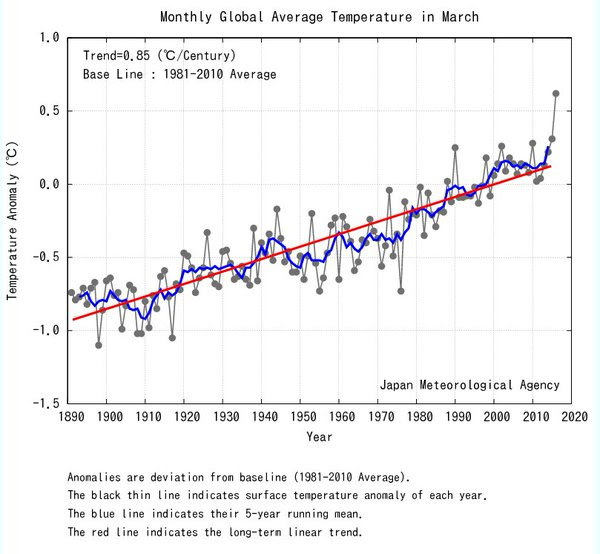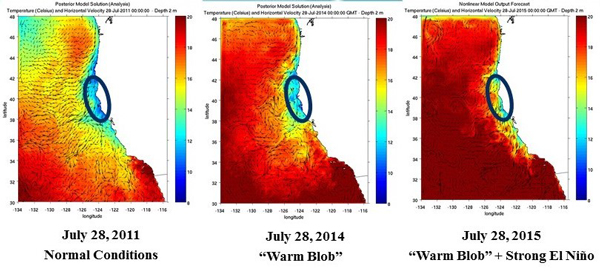Global Warming Warps Mgt. Lens
continuted from September 2016 Homepage

JMA: Global temp records smashed (again) in March, 1.07°C above 20th C avg. Global Graphics
However, the NEFMC letter says, NOAA’s draft plan “seems to oversell the state and timeliness of the science supporting management decisions. While there has been a considerable amount of ecosystem and climate science activity and model development that the NEFSC [Northeast Fisheries Science Center] has produced, incorporation into stock assessments (either single species with climate and ecosystem-informed reference points and projections) has so far been limited.
“On several occasions, ecosystem and climate effect considerations were examined during an assessment (such as the influence of temperature on recruitment, and in at least one instance, for scallops, the impact of a predator on scallop recruitment). These analyses were brought forward with the specific intent of incorporating the results into the assessment models. Unfortunately, during the review process, the analyses were not accepted by either the working groups or the reviewers because of poor model fits or bad diagnostics.”
According to the plan, climate change will affect most living marine resources, either negatively or positively. All interactions between humans and marine resources—including commercial fishing, recreational fishing, tourism, and aquaculture—will also be affected.
Expected to be impacted are 450-plus fishery species, 117 marine mammals, and 93 species listed under the Endangered Species Act.

Dramatic water temperature changes off coastal California between 2011 and 2015.
The plan’s top priorities include:
• Give greater emphasis to climate-related terms of reference and analyses in stock assessments.
• Continue development of stock assessment models that include environmental terms such as temperature and ocean acidification.
• Develop climate-related products and decision support tools to for protected species assessments and other management actions.
• Increase social and economic scientist involvement in climate change research.
• Examine the effect of different management strategies under climate change.
• Improve spatial management of marine resources through an increased understanding of spatial and temporal distributions, migration, and phenology.
• Continue to build industry-based fisheries and ocean observing capabilities and use information to develop more adaptive management.
• Work with NOAA and academic scientists to develop short-term (day to year) and medium-term (year to decade) marine resource forecasting products.
• Work with NOAA and academic scientists to develop and improve regional hindcasts and climatologies.
• Conduct research on the mechanistic effects of multiple climate factors on marine resources with a goal of improving assessments and scientific advice provided to managers.
According to the plan, the Northeast U.S. Shelf Ecosystem supports a wide array of living marine resources from Atlantic sea scallops, one of the most valuable, to the North Atlantic right whale, one of the most endangered.
“All of these resources—fish, invertebrates, marine mammals, sea turtles, habitats, and other ecosystem components—are being impacted by climate change and multi- decadal climate variability,” the plans says. “In fact, the pace of observed climate change in the Northeast U.S. is faster than in many of the other U.S. Large Marine Ecosystems, and future change in the Northeast U.S. Shelf ecosystem is projected to be greater than other portions of the world’s oceans. These changes in climate are already creating significant challenges for the region. Species distributions are becoming out-of-sync with the spatial allocations of management. The productivity of some iconic species is decreasing making rebuilding and recovery difficult. Some ports rely on one or two fisheries; changes in these fisheries could have dramatic consequences for the human communities connected to these ports. Changes in management and regulation are slow, while changes in the physics, chemistry, and biology of the ecosystem are occurring rapidly.”
Despite the challenges, there are opportunities, the plan says.
“Some species in the region are responding positively to the changes: moving into the region and increasing in productivity. Technology offers new tools for observing, understanding, and adapting to change. The region has an excellent marine science infrastructure.”
